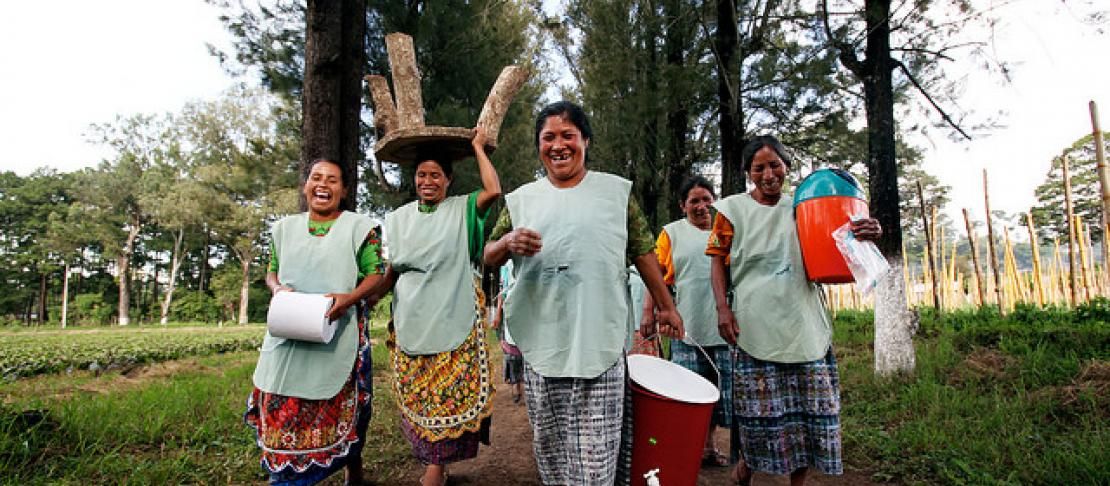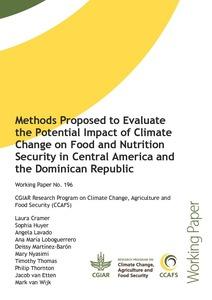Five methods to evaluate the potential impact of climate change on food and nutrition security

A new CCAFS paper discusses five methods to analyze the multiple dimensions in which climate change, agriculture and food and nutritional security are related.
One of the constant threats to food and nutritional security (FNS) is climate change. Exploring how this vulnerability manifests itself has been of interest to science, which has mainly focused on the interaction between these two events through agricultural production.
In this context, a new working paper discusses five methods to analyze the multiple dimensions in which climate change, agriculture and FNS are related. Since there is no recognized methodology in the scientific field as the only answer to evaluate the interaction between these three concepts, the document presents the different tools available to address the issue.
Download the working paper:
The first tool discussed includes food and nutrition scenarios that combine socio-economic and climate information to enable better planning of interventions and can be applied at different levels (global as sub-national). For the design of these scenarios, key stakeholders are consulted to identify focus areas, modelling the scenarios identified and the results are calibrated with existing experiences.
The data included reflect performance, production and aggregate demand while taking into account factors such as the availability and diversity of food, access to biofortification, water resources, governance and natural resources. This methodology was already implemented in Honduras to develop the strategy for adaptation to climate change. In all the calculated scenarios, it is observed that the production increases accompanied the demand, and therefore, the available calories.
The second methodology includes different models of regional and national food systems. These include the International Model for Policy Analysis of Agricultural Products and Trade (IMPACT) developed by the International Food Policy Research Institute (IFPRI). IMPACT combines different climate, hydrological, crop simulation, value chains, land use, nutrition, health and wellness models to identify opportunities and challenges for FNS and natural resources management. The model contains five components with different models and monthly information is available, allowing daily calibration up to 2050.
The hydrological model estimates distribution of rainfall, runoff, potable water and available irrigation to calculate the impact of water resources on agricultural yields. Water demand is calculated by incorporating the needs of agriculture, industry and people. The livestock and food production and the markets are modeled with which it is possible to estimate the effects of the variations in the same ones on the FNS. As a result, IMPACT allows the estimation of the population at risk of hunger under the different conditions considered. One of the main conclusions obtained through this methodology is that more crops will be adversely affected by climate change, so investments in adaptation and mitigation measures need to be made.
The third methodology consists of the Gender Toolbox, which allows to observe the differences in the experiences of women and men in the face of climate change. These tools establish the forms of analysis and integration of gender issues in interventions from the design stage to the evaluation.
This tool has been applied, for example, to climat-smart agriculture (CSA) interventions, as it is useful for assessing the vulnerability of men and women to climate change according to the different agricultural activities they perform in the farm/household production. The toolbox is also inclusive of community participation and considers several qualitative methods for analysis. Participatory workshops have been implemented in Africa and Latin America.
The fourth method is surveys and databases as tools to know and monitoring the state of the agricultural sector. The Rural Household Multiple Indicator Survey (RHoMIS) is the most well-known of these tools, grouping in a standardized way different indicators through the food system. These indicators include data on agricultural production, gender, nutrition and poverty from individual surveys, together with CSA relevant estimates based on the characteristics of the farm and production. Information on natural resource management, sustainable agriculture, organic agriculture, pest control, fertilizer use and others can also be included in RHoMIS according to need. The implementation of this survey has identified hidden hunger presented in households in Guatemala, that is, high caloric intake but with a lack of micronutrients.
The second tool proposed in this methodology is the IMPACTLite, Integrated Modelling Platform for Mixed Animal Crop systems, which allows the capture of information on different agricultural activities and characterizes the main agricultural production systems , Contributing to the monitoring of programs or interventions in matters of food and nutritional security.
The last methodology is about the Climate-Smart Villages (CSV). This approach refers to the comprehensive study of the application of CSA practices to a defined group of smallholder farmers. This process involves monitoring the implementation of different strategies at the community level, according to the preferences of the farmers, which allows the study of specific and combined strategies to be scaled. In the CSV approach, each community chooses the strategies to be implemented according to their needs in a participatory manner, generating evidence regarding the management of resources, agricultural results and reduction of emissions.
The authors acknowledge that the value of these methodologies lies in the fact that, in the region, most of the studies are focused on the effects of climate change on agricultural production. The methodologies discussed above allow the analysis to be expanded to consider the interaction between climate change, food security and agriculture. It is proposed to focus efforts on expanding the portfolio of options for communities and farmers through participatory processes, suggesting appropriate adaptation measures for each particular community, and promoting actions that improve adaptation to climate change, food security and mitigation.
Download the working paper:
Cramer L, Huyer S, Lavado A, Loboguerrero AM, Martínez-Barón D, Nyasimi M, Thomas T, Thornton P, van Etten J, van Wijk M. 2017. Methods Proposed to Evaluate the Potential Impact of Climate Change on Food and Nutrition Security in Central America and the Dominican Republic. CCAFS Working Paper no. 196. Wageningen, Netherlands: CGIAR Research Program on Climate Change, Agriculture and Food Security (CCAFS).
Florencia Paz is Senior Research Assistant at the International Food Policy Research Institute (IFPRI). This text was edited with permission of the author. The original can be consulted in the Food Security Portal Latin America and the Caribbean, facilitated by IFPRI.




